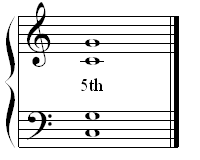I've had a couple of members inquire about major and perfect intervals. Since I was forceful about knowing intervals in the last post I thought I'd post part of my responses here.
Interval Study
Our section on intervals starts at the following link. In the main site at: Intervals
Review the interval pages to get more familiar with the major and minor intervals.
 Just after the keyboard graphic I list all the major intervals. The fourth and fifth are considered major intervals although they do get the label of perfect interval. As does the 8th interval or octave.
Just after the keyboard graphic I list all the major intervals. The fourth and fifth are considered major intervals although they do get the label of perfect interval. As does the 8th interval or octave.
When it comes to defining major intervals they are based on the major scale. More here: Major scales
Major Scale Defines Major Intervals
That is the scale definition itself is used to define the major intervals. They have a specific relationship in physics and mathematics as well. They also have a distinct sound as they are related to the tonic or root note.
Of the 12 tone scale, 8 are considered major intervals, if you include the 1 or unison note. In the key of C, the C major scale has all the major intervals which can be shown with all the white notes on a keyboard from C to C.
For defining perfect intervals a detailed explanation can be found here at wikipedia for the perfect fifth. They have a good definition and get more detailed about the relationship and physics.
http://en.wikipedia.org/wiki/Perfect_fifth
The term perfect refers to their simple pitch relationships and their high degree of consonance. Which gets into the physics of wave motion and sound that you hear.
At the bottom of the wiki page you can link to other intervals for way to much information for most of us to have to consider, but if you have a scientfic or engineering mind you may find it of interest.
Practical Theory Not Quantum Physics
In our lessons and theory course we go after the practical application of music theory rather than the physics. For most of the musicians in the world it's understanding and knowing relationships and not necessarily the mathematical physics.
However, if you get into the world of sampling and digital sound generation you will likely need to get into depth with the basic mathematics.
The only significant difference between major and perfect labels for intervals is the consonance or harmonic sound quality of the perfect intervals. For practical application the perfect 4th and 5th are major intervals.
Minor intervals
Minor intervals are just a different shade of the major interval and sometimes refered to as diminished. Which simply means to flat the note one half step. This is most often used for the 5th interval where it is called a diminished fifth rather than a minor 5th.
Learning the intervals is important, these concepts are important to know once you begin building seventh chords.
If you know more about intervals and would like to share your knowledge with the group please add your comments.
Stay tuned!